Two New Hyperon Coupling Models in the Light of the Massive Neutron Star PSR J0348+0432?
Bin Hong (洪斌), Zhong-Zhou Ren (任中洲), and Dong Bai (柏棟)
1School of Physics,Nanjing University,Nanjing 210093,China
2School of Physics Science and Engineering,Tongji University,Shanghai 200092,China
3Key Laboratory of Advanced Micro-Structure Materials,Ministry of Education,Shanghai 200092,China
Abstract In the context of the relativistic mean field theory,we propose two new hyperon coupling models,namely the limitation model and the potential well depth model,in the light of the observed data for the massive neutron PSR J0348+0432.The radius of PSR J0348+0432 given by the limitation model is found to be 12.52 km~12.97 km,while the radius given by the potential well depth model is found to be 12.19 km~12.89 km.We also calculate the gravitational redshift of PSR J0348+0432 within these two models,for which the limitation model gives 0.346 ~0.391 and the potential well depth model gives 0.350 ~0.409.Further exploration of these two models shows that,these two models are almost degenerate for neutron stars lighter than 1.85M⊙,and start to give different results for massive neutron stars heavier than 1.85M⊙.Therefore,the studies of massive neutron stars could be crucial for discriminating these two models and help deepen our understanding of hyper-nuclear interactions.
Key words: hyperon coupling parameter,potential well depth,PSR J0348+0432
1 Introduction
Neutron stars as compact stars provide an excellent platform to study extreme matter conditions,extending to nuclear physics,particle physics,and general relativity.Recently,the gravitational wave event GW170817 has made neutron stars run into a hot topic.[1?3]In this field,massive neutron stars are of particular interest,which continuously challenge our traditional wisdom of hadronic systems.In 2013,a massive neutron star of 2.01±0.04M⊙was observed by Antoniadiset al.[4]and is named as PSR J0348+0432.It is important to build theoretical models to explain its observed properties.
In literature,various models have been proposed to explain the observed properties of PSR J0348+0432,such as the effective nonrelativistic potential models,[5]the relativistic mean field models,[6?9]the chiral effective lagrangians,[10]and the Brueckner-Hartree-Fock approaches.[11?12]In this work,we propose two new models on the hyperon couplings within the framework of the relativistic mean field theory,namely the limitation model and the potential well depth model,and see how the massive neutron star PSR J0348+0432 constrains on the parameter space.
The rest part of this work is organized as follows: In Sec.2,we give a brief introduction to the RMFT for neutron stars.In Sec.3,we give a detailed discussion on construction and selection of two hyperon coupling models.In Sec.4,some results be provided and Sec.5 ends this work with summaries.
2 Relativistic Mean Field Theory
The Lagrangian density with the octet baryons included is given as follows:[13]

The energy density and pressure of a cold,stable and non-rotating neutron star can be read as:


The physical signs ofB,l,m?=mB?gσBσare baryon number,lepton number and effective mass,respectively.
What is more,the whole neutron star system also yields to charge neutrality and chemistry potential equilibrium:

From the Tolman-Oppenheimer-Volkoff equation,the mass and radius of a neutron star can be obtained:[14]

3 Limitation Model and Potential Well Depth Model
In this work,the nucleon parameters are taken from the well-known GL85 model and are reproduced here in Table 1.Thegi≡giNdenotes the nucleon-meson coupling constant,with the subscripti=σ,ρ,andω.g2andg3are the nonlinear coupling constants for theσsector.ρ0,B/A,K,asym,m?/mare the saturation density,the binding energy per nucleon,the compression modulus,the symmetry energy coefficient,and the effective mass,respectively.Compared with the nucleon parameters,the hyperon coupling constants are less known.In Ref.[15],only a broad range of 1/3~1 is found.

Table 1 The nucleon coupling parameter sets GL85.
We propose two different models to describe the massive neutron stars.In both models,they adopt quark model (SU(6) symmetry)[16?18]in determining coupling parameters betweenρmeson and baryons,while,adopt two different methods in determining coupling parameters amongσandω.We call one of them as limitation model,another as potential well depth model.
3.1 Limitation Model
For convenience’s sake,we introduce the ratios between the hyperon coupling constants and the nucleon coupling constants:

The hyperon coupling parametersxρHare given by the SU(6) symmetry:[19]

Due to the uncertainty on hyperon coupling parameters,we selectxσandxωat the range mentioned above.For eachxσ=0.3,0.4,0.5,0.6,0.7,0.8,0.9,we selectxω=0.3,0.4,0.5,0.6,0.7,0.8,0.9,respectively.
We calculate the maximum mass of the neutron star for each pair of the hyperon couplings (xσ,xω),and reserve only those hyperon-coupling pairs that lead to the maximum mass exceeding 2.05M⊙,otherwise will be deleted.

Fig.1 (Color online)Mass-central density relation of a neutron star for different xω,which corresponds to xσ=0.3 and xρΛ=0,xρΣ=2,xρΞ=1.
The first step,whenxσ=0.3,the corresponding value ofxωselected as 0.3,0.4,0.5,0.6,0.7,0.8,0.9.We plot the results in Fig.1.There are three cases in which the masses have exceeded 2.05M⊙,they arexω=0.7,0.8,0.9,respectively.Therefore,these parameter sets can be utilized to study massive neutron star PSR J0348+0432.
Whenxσ=0.4,0.5,0.6,0.7,the corresponding value ofxωalso selected as 0.3,0.4,0.5,0.6,0.7,0.8,0.9 respectively.The results are plotted in Fig.2.There are three cases corresponding toxσ=0.4,two cases corresponding toxσ=0.5,one case corresponding toxσ=0.6 andxσ=0.7 respectively.
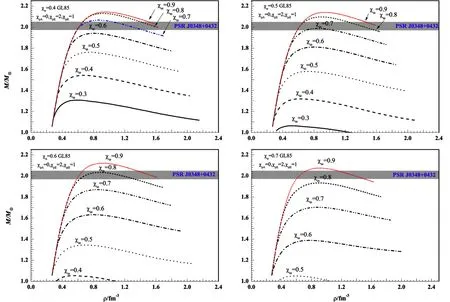
Fig.2 Mass-central density relation of a neutron star for different xω,which corresponds to xσ=0.4,0.5,0.6,0.7 and xρΛ=0,xρΣ=2,xρΞ=1.

Fig.3 (Color online)Mass-central density relation of a neutron star for different xω,which corresponds to xσ=0.8,0.9 and xρΛ=0,xρΣ=2,xρΞ=1.
However,thexσequals 0.8 or 0.9,the result can not give the mass which could exceed 2.05M⊙,we can read it in Fig.3.

Table 2 The practicable hyperon coupling parameter sets for studying massive neutron stars.
In summary,ten sets of the hyperon coupling constants are found for the limitation model,which give the maximum neutron-star mass exceeding 2.05M⊙a(bǔ)nd can be used to study the massive neutron star.A list of these hyperon coupling constants could be found in Table 2.
3.2 Potential Well Depth Model
In the context of hyper-nuclear potential well depth model,the hyperon coupling parameterxρHare determined by SU(6) symmetry as well,i.e.,xρΛ=0,xρΣ=2,xρΞ=1.The value ofxωandxσare also strictly constricted from 1/3 to 1,but the choice among thexωandxσshould be held accountable for the relation:[15,20]

whereUNHrepresents the hyper-nuclear potential well depth,it depends on the available hyper-nuclear experimental data.Recent experimental data suggests that the hyperon potential of Λ,Σ,Ξ are probably given by:[21?27]

The value ofxσwill determine the value ofxωaccording the above relation.ForxσΛandxωΛ,whenxσΛequals 0.3 and 0.9,the corresponding value ofxωΛwe obtain are 0.227 and 1.073 respectively,both of which fall short of the range we need,therefore,we selectxσΛas 0.4,0.5,0.6,0.7,0.8 and thexωΛobtained as 0.368,0.509,0.650,0.791,0.932 respectively.
ForxσΞa(chǎn)ndxωΞ,xσΞ,xσΞ=0.3 and 0.9 will givexωΞ=0.24 and 1.085,which also lie outside [1/3,1].Therefore,we takexσΞ=0.4,0.5,0.6,0.7,0.8,with the correspondingxωΞ=0.381,0.522,0.663,0.804,0.945.
ForxσΣandxωΣ,there are only two available sets:xσΣ=0.4,xωΣ=0.760 andxσΣ=0.5,xωΣ=0.901.The positive potential well depthUNΣwill hamper the production of Σ,so we will only selectxσΣ=0.4,xωΣ=0.760 as the best candidate.The specific value are listed in Table 3.In summary,we have twenty-five candidate parameter sets for the hyperon coupling constants,which could be seen in Table 4.

Table 3 The value of xσ and xω are depending on the available hyper-nuclear experimental data.
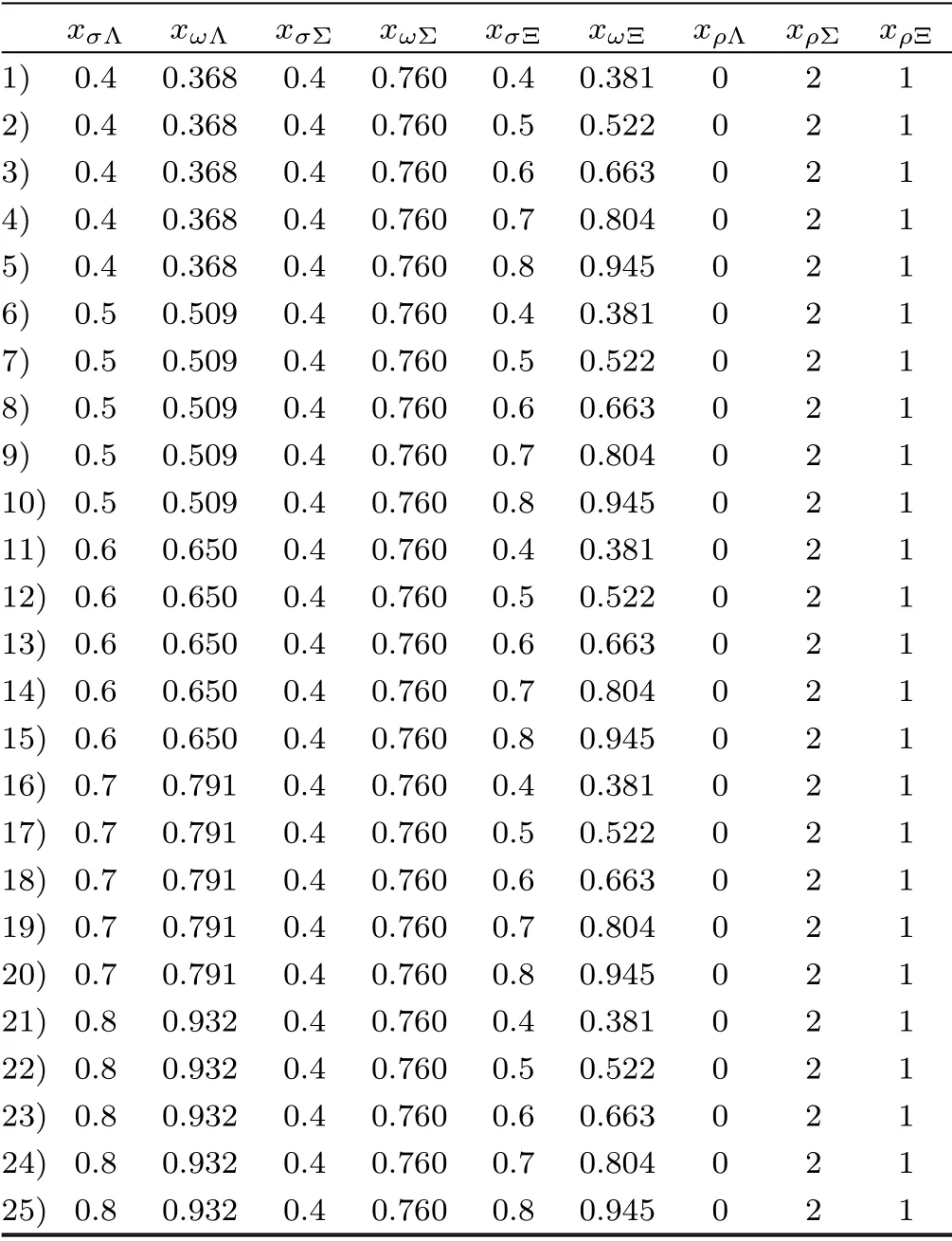
Table 4 Twenty-five combinations of hyperon coupling parameter sets are depending on the available hyper-nuclear experimental data from Table 3.
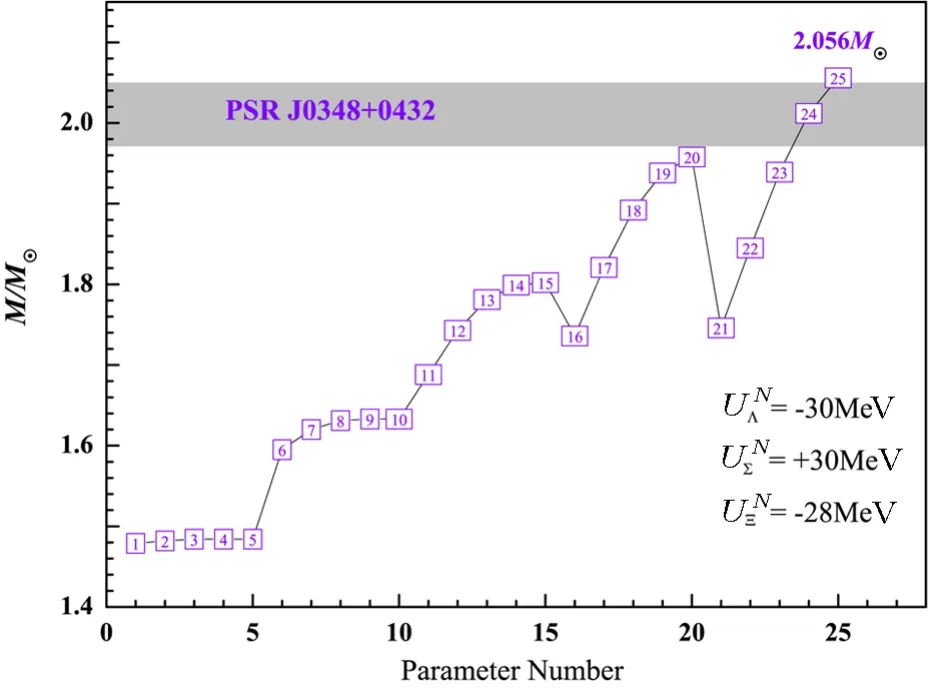
Fig.4 (Color online)The maximum neutron-star mass given by the twenty-five parameter sets of the hyperon couplings in the potential well depth model.
In this section,the method we discussed is similar with above section,we will use 25 sets of hyperon coupling parameter to calculate the maximum mass of neutron star.We hope that the maximum mass could exceed 2.05M⊙,otherwise the set will be deleted.The result is shown in Fig.4,which shows that only the 25th parameter set satisfies the above requirement.
4 The Results and Discussions
In the above section,limitation model gives ten sets of practicable hyperon coupling parameters listed in Table 2,and potential well depth model with only one available set depicted in Fig.4.Now we use above sets to calculate radius and gravitational redshift of massive neutron stars,for the PSR J0348+0432,whose mass is about 1.97~2.05M⊙.[4]
4.1 Mass-Radius Relationship of Limitation Model and Potential Well Depth Model.
In the limitation model,for the PSR J0348+0432,the radius is found to be 12.97 km at the lower limit of the experimental mass value 1.97M⊙,and ranges from 12.52 km to 12.66 km at the upper limit of the experimental mass value 2.05M⊙(see the colorful lines in Fig.5).In the potential well depth model,the radius of PSR J0348+0432 is found to be 12.19 km at the lower limit 1.97M⊙a(bǔ)nd 12.89 km at the upper limit 2.05M⊙(see the black line of Fig.5).
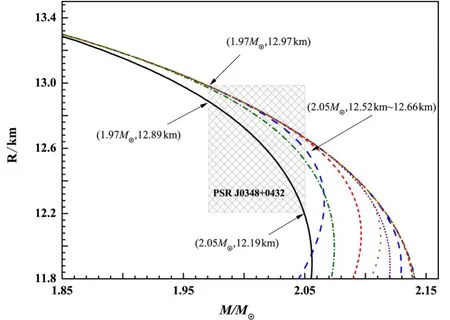
Fig.5 (Color online) Mass-radius relation with limitation model and potential well depth model.
These results show that the radius of PSR J0348+0432 could be determined theoretically with small errors,and ranges from 12.52 km to 12.97 km in the limitation model and from 12.19 km to 12.89 km in the potential well depth model.
4.2 Mass-Gravitational Redshift Relation
The gravitational redshift is an important physical observable in neutron-star physics and could be calculated by:[28?29]

In the limitation model,for the PSR J0348+0432,the gravitational redshift is found to be 0.346 at the lower limit of the experimental mass value 1.97M⊙.At the upper limit of the experimental value 2.05M⊙,the gravitational redshift ranges from 0.384 to 0.391(see the colorful lines in Fig.6).In the potential well depth model,the gravitational redshift of PSR J0348+0432 is about 0.350 at the lower limit 1.97M⊙a(bǔ)nd 0.409 at the upper limit 2.05M⊙(see the black line in Fig.6).
These results show that the gravitational redshift of PSR J0348+0432 be determined theoretically with small errors,which are about 0.346~0.391 in the limitation model and about 0.350~0.409 in the potential well depth model.
A summary of the theoretical values of the radius and the gravitational redshift of PSR J0348+0432 in the limitation model and the potential well depth model could also be found in Table 5,which are also consistent with recent astronomical observations.

Fig.6 (Color online) Mass-gravitational redshift relationship with limitation model and potential well depth model.

Table 5 Radius (R) and gravitational redshift (Z) of RSR J0348+0432 (1.97 M⊙–2.05 M⊙) under limitation model (L Model) and potential well depth model (P Model) respectively.
4.3 Discussions
This section gives some further remarks on the limitation and potential well depth model in the studies of massive neutron stars.The radius of PSR J0348+0432 given by the limitation model is bigger than that given by the potential well depth model.Explicitly,in the limitation model,the radius of PSR J0348+0432 is around 12.52 km~12.97 km,while in the potential well depth model,the radius is found to be around 12.19 km~12.89 km.The gravitational redshift of PSR J0348+0432 given by the limitation model is,on the other hand,smaller than that given by the potential well depth model,and it is around 0.346~0.391 in the limitation model and 0.350~0.409 in the potential well depth model.
The equation of state (EOS) (Fig.7) and the particle number distribution(Fig.8)could be held accountable for this conclusions.
From Fig.7,the logarithm of central energy density logεthat exceed 14.94 g/cm3gradually reveals the difference between these two models,and Fig.8 tells us the hyperons of potential well depth model appear at 0.44 fm?3,while the hyperons of limitation model(color line)appears in succession from 0.52 fm?3.

Fig.7 (Color online) The EOS of limitation model and potential well depth model.
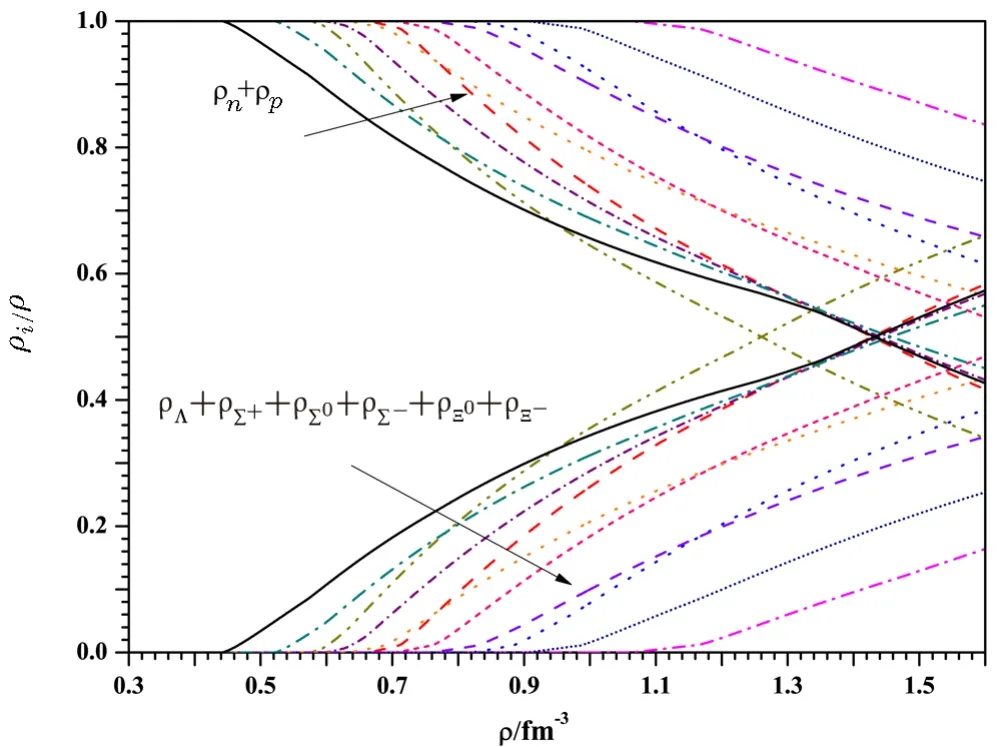
Fig.8 (Color online) The particle number distribution of limitation model and potential well depth model.The upper part represents nucleonic density and the lower part represents the sum of hyperon density.
For the sake of a best understanding on particle number distribution,we select a typical parameter set from limitation model that can support a neutron star with mass above 2.05M⊙,and make a comparison with the single set from potential well depth model,we plot it in Fig.9.As a result,in limitation model,the density at where Λ that as the first hyperon appears is 0.66 fm?3,while 0.44 fm?3in potential well depth model,This result clearly manifest a result that the hyperons do not appear at the density below 0.44 fm?3in both models,thus the two models will give an almost same conclusion for calculating a neutron star.
In general,for neutron stars lighter than 1.85M⊙,these two models give degenerate numerical results,and start to give different results for neutron stars heavier than 1.85M⊙.At present,the experimental data for massive neutron stars are still limited,and both models are consistent with the recent observations of PSR J0348+0432.Future observations of massive neutron stars might help discriminate these two models.

Fig.9 (Color online) (a) the particle number distribution of a typical parameter set in limitation model.(b)the particle number distribution of potential well depth model.The central density of a neutron star with 2.05M⊙a(bǔ)re given in corresponding models.
5 Summary
In the framework of relativistic mean field theory,we propose two hyperon coupling models,namely the limitation model and the potential well depth model,and study their parameter space in the light of the observed properties of the massive neutron PSR J0348+0432.Ten parameter sets are found for the limitation model,and one parameter set are found for the potential well depth model.These parameter sets could be used to study massive neutron stars.
Numerical calculations show that the radius of PSR J0348+0432 given by the limitation model is bigger than that given by the potential well depth model.Explicitly,the radius of PSR J0348+0432 given by the limitation model is about 12.52 km~12.97 km,while the radius given by the potential well depth model is about 12.19 km~12.89 km.The gravitational redshift of PSR J0348+0432 given by the limitation model is,on the other hand,smaller than that given by the potential well depth model,and is around 0.346~0.391 for the limitation model and around 0.350~0.409 for the potential well depth model.
Furthermore,we find that,in general,these two models give almost the same results on a neutron star lighter than 1.85M⊙,and start to give different results for neutron stars heavier than 1.85M⊙.In other words,the study of the physical properties of massive neutron stars could be crucial for discriminating these two models and help deepen our understanding of hyper-nuclear interactions.
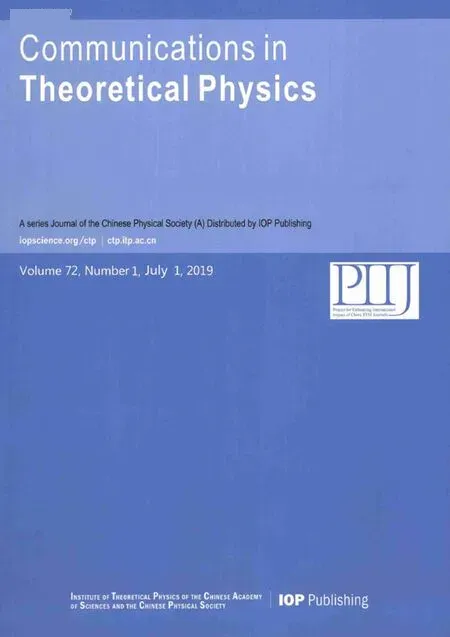 Communications in Theoretical Physics2019年7期
Communications in Theoretical Physics2019年7期
- Communications in Theoretical Physics的其它文章
- Tunable Range Interactions and Multi-Roton Excitations for Bosons in a Bose-Fermi Mixture with Optical Lattices?
- Holographic Entanglement Entropy: A Topical Review?
- Doubly Excited 1,3Fe States of Two-Electron Atoms under Weakly Coupled Plasma Environment?
- A Renormalized-Hamiltonian-Flow Approach to Eigenenergies and Eigenfunctions?
- Scalar Tensor Cosmology With Kinetic,Gauss-Bonnet and Nonminimal Derivative Couplings and Supersymmetric Loop Corrected Potential
- Hydrodynamic Stress Tensor in Inhomogeneous Colloidal Suspensions: an Irving-Kirkwood Extension?
